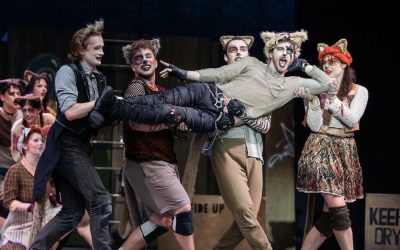
Mr. Burns, a post-electric play, reinvents The Simpsons—and gets to the heart of storytelling.
WTF is one of my favourite responses at the theatre. I had it a lot while watching Mr. Burns, a post-electric play.
Part of the pleasure of watching Mr. Burns is that the three acts are so different that you have to re-orient yourself after each of the intermissions. If you want to preserve that sense of bafflement and discovery for yourself, don’t read too much more of this review, just buy your tickets now. I highly recommend this show.
If you’re still reading, I’ll try not to give too much away.
Playwright Anne Washburn sets Act 1 of Mr. Burns in a post-apocalyptic near future. An unspecified disaster has set off a chain of events that involved the meltdown of nuclear power plants. We’re with a small group of survivors who are sitting around a campfire and trying to bring reassuring order back to their lives by reconstructing “Cape Feare”, an episode from The Simpsons.
Act 1 is a potent combination of kitsch and dread. There’s a lot of humour to be had in watching the characters’ impersonations of Homer, Bart, and Sideshow Bob. But there’s also a riptide of sorrow. When a new person arrives, everybody gets to list the names of ten loved ones. Has anybody seen Petra Suarez-Evans? Is she still alive?
Especially with Donald Trump as US President, this is one of the futures we fear, so the impact is visceral.
My connection with Act 2 was less potent. Seven years have passed and the characters from Act 1 have become a theatre company that acts out half-remembered Simpsons scripts. But theirs isn’t the only show in town. They are competing with other troupes for the rights to episodes and lines. Playwright Washburn may be commenting on the resiliency of capitalism or on the undermining influence of commerce on art, but Act 2 basically felt like a copyright discussion to me and I didn’t much care.
Then Act 3 threw me for a satisfying loop. Another 75 years have passed and we’re watching a company perform an opera in which characters from The Simpsons have become archetypal figures. Given that surviving humanity is still struggling with the trauma of global devastation, it’s not surprising that Mr. Burns, the owner of a nuclear power plant, has replaced Sideshow Bob as the villain. The struggle between good and evil is enacted in primal terms: Itchy and Scratchy, the violent cartoon mouse and cat from The Simpsons become Burns’s amoral henchmen.
In Act 3, Washburn’s mediation on culture ripens. Throughout Mr. Burns, a post-electric play, she presents civilization as a palimpsest, a deep stack of pages that have been endlessly written, half erased, and written over. A major part of her point, it seems, is that we build culture out of artifacts: The Simpsons’ “Cape Feare” episode riffed on Martin Scorsese’s 1991 film Cape Fear, starring Robert De Niro, and that film was, in turn, a remake of the 1962 Robert Mitchum vehicle. As we watch the Act 3 opera, we’re aware of the ways in which the Act 1 stewards of memory have influenced the story: because one of them remembered the episode’s references to Gilbert and Sullivan, for instance, the opera quotes from The Mikado. And it’s all metatheatrical: as we watch our potential descendants manipulating cultural shards in an attempt to create a coherent narrative, achieve communion—and stay alive spiritually—we are doing the same thing. Cool.
As if that weren’t enough, there’s also a whole lot of theatrical shakin’ goin’ on. That shakin’ isn’t perfect in this production, but it is pretty damn impressive.
Musical director Katerina Gimon has created a complex original score for this mounting and this seven-member cast sings it very well. Stephanie Izsak, who sings Mr. Burns in Act 3, and Graham Coffeng, who sings Homer, are particularly strong vocally.
And Gimon exploits the talents of individual actors, so CJ McGillivray gets a touching ukulele solo as Lisa and Matt Montgomery turns into a tap-dancing feline rhythm king as Scratchy.
Speaking of rhythm, in Act 2, there’s an extended song-and-dance sequence that features pre-Armageddon pop hits. Director Madelyn Osborne’s choreography is a winning combination of sex and hilarity.
Keara Barnes delivers one of the most naturalistic performances of the evening as a survivor named Jenny and, when she sings Bart, who becomes a tragic hero, her restraint is touching.
There are glitches elsewhere. At a couple of crucial junctures—a first-act monologue and the Act 3 ukulele solo—McGillivray’s lack of enunciation makes her hard to understand. As he plays a survivor named Sam in Act 1, Montgomery’s slack delivery leeches tension. And, although Douglas Ennenberg’s understated performance as an intruder named Gibson is one of the touchstones of the first act, his characterization becomes strangely affected in Act 2.
Heipo C.H. Leung’s set design is visually distracting—Why paint the risers in a bold black-and-white design?—and it causes some problems, forcing the action too far downstage in Act 1, for instance, which messes up the sightlines.
The strengths of this production massively outweigh its occasional soft spots, however. I feel like I was kidnapped and taken to surprising places, places that I hadn’t known I wanted to go.
MR. BURNS, A POST-ELECTRIC PLAY By Anne Washburn. Original score for this production by Katerina Gimon. Directed by Madelyn Osborne. Produced by Little Mountain Lion Productions. At Studio 1398 on Saturday, April 7. Continues until April 21.
NEVER MISS A REVIEW: To get all my reviews—plus curated local, national, and international theatre coverage—once a week, sign up for my newsletter It’s free! It’s easy. It’s downright luxurious.





0 Comments